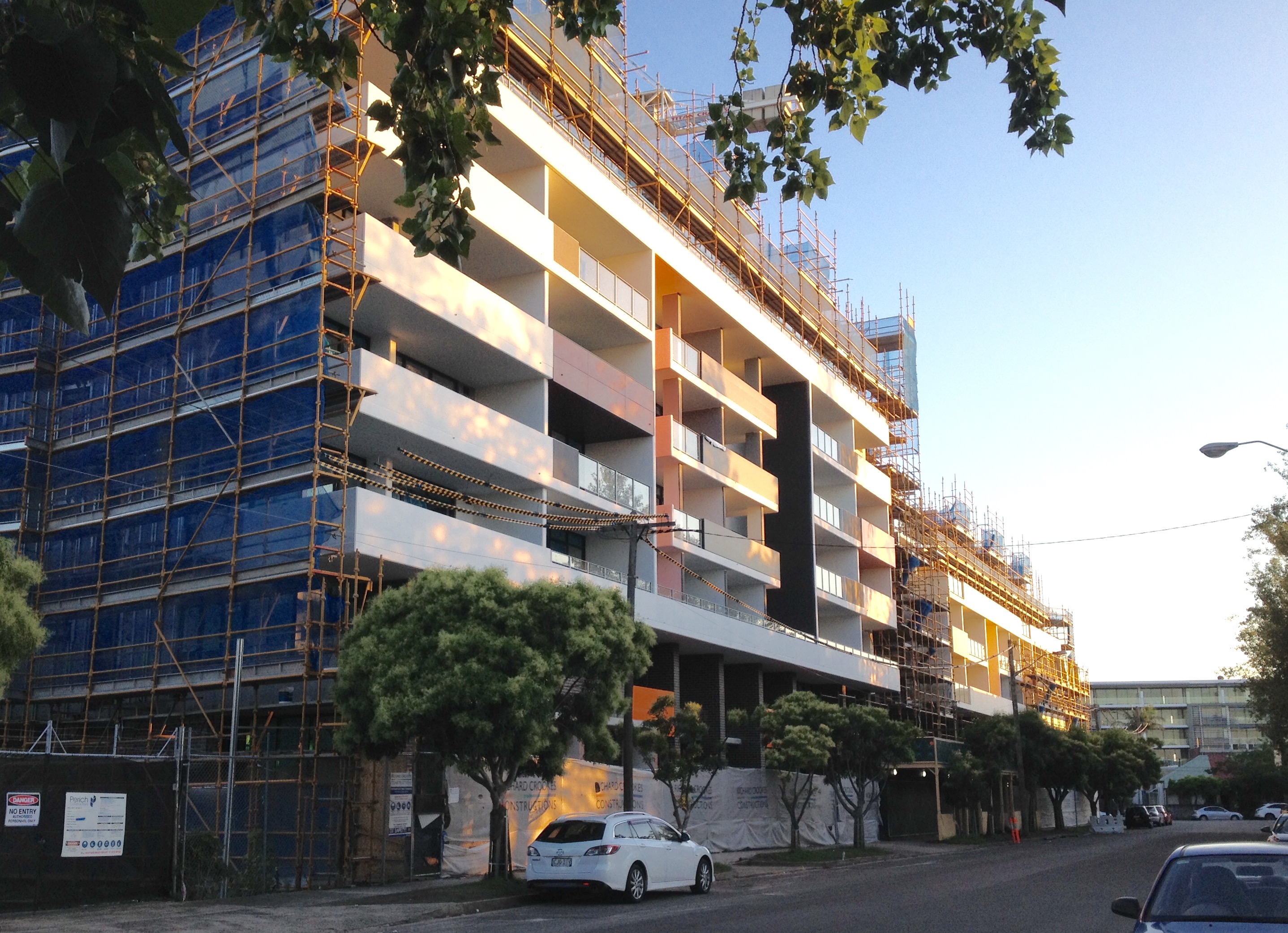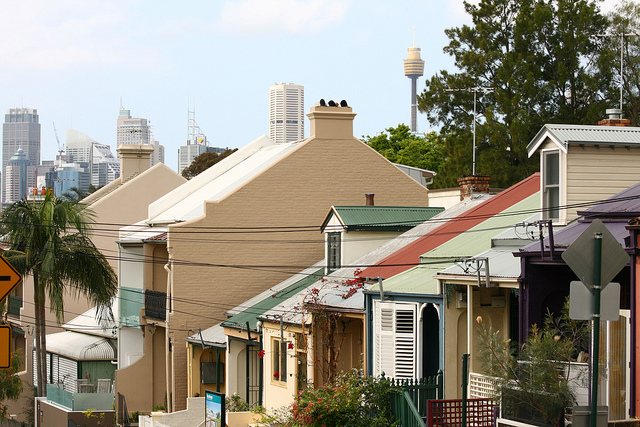The latest CityWest Housing affordable rental block, Portman Street, Zetland, under construction in 2015
Make no mistake; in the ranking of Australian urban governance innovations, the founding of the Greater Sydney Commission looks set to prove a major league event. Established by the NSW Government at the start of 2016, the GSC’s role is to create a strategic framework for local planning across the entire Sydney metropolis. Judging from last week’s Sydney Morning Herald story, affordable housing looks to be one area where the GSC could have an immediate step-change impact on our city, state, and maybe even other parts of Australia.
According to the Herald, the GSC’s district plans – due out later this month – will incorporate scope for affordable housing targets for new residential developments on re-zoned land. Such projects will be required to include a quantified component of ‘affordable housing’ for low income workers to rent from community housing providers.
This kind of ‘inclusionary zoning’ intervention is already commonplace in comparable countries such as the UK and USA. Albeit of a minimal form, there are even precedents in Australia. In NSW a similar policy has existed in designated zones in the City of Sydney for more than 20 years. In the Pyrmont Ultimo and Green Square renewal projects modest developer contributions have been channelled to affordable housing projects built and managed by CityWest Housing. However, while certainly worthy these schemes have yielded only 750 affordable rental homes over more than two decades. And although other states and territories have previously claimed the introduction of so-called inclusionary zoning for affordable housing, our research has shown that these measures have tended to be relatively toothless – e.g. where developers can fulfil their obligation simply by including in their scheme a proportion of for-sale units commanding a lower price by virtue of their small size.
Some property lobby groups have cried foul in response to the reported GSC position. Arguing that such a policy could have a ‘very dangerous impact’, the Urban Development Institute of Australia contends that the cost of an affordable housing obligation will be borne by purchasers of ‘market sale’ homes. Similarly, the policy has been derided as ‘another form of taxation on housing’.
However, claims of this sort are highly questionable. In a properly-functioning land market, it is the land value not the market price of homes for sale that will be impacted by any planning requirement limiting the scope for sale of an entire development at the market price. After all, urban land values are an artificial construct, strongly influenced by the allowable uses for the site concerned. Unjustifiably, therefore, status quo arrangements enable owners of ‘up-zoned’ land to reap un-earned and untaxed super profits when, for example, planners raise a local development height limit from two stories to six stories.
And reflecting an appreciation that an affordable housing obligation will depress land acquisition costs, resistance to inclusionary zoning for affordable housing is, in fact, far from universal across the development industry. Among the strongest backers of such a policy is the Committee for Sydney, well-known as a business-supported lobby group. A recent CFS report sponsored by Payce Communities and endorsed by Lend Lease contends that affordable housing obligations would be perfectly acceptable to many developers provided these responsibilities are clearly defined before the relevant site is purchased. In this way a developer can allow for the cost of providing affordable housing in the price they are willing to pay for the land.
There will be some developers whose efforts to anticipate re-zoning designations may have led them to buy sites at prices more reflective of their expected allowable use rather than their current zoning designation. In other words, they have gambled on an administrative event delivering them a windfall. If the anticipated change of landuse decision in fact comes with inclusionary zoning strings attached they may find that projected development profit margins are squeezed. What this means is that a reformed planning regime linking inclusionary zoning with re-zoning would discourage land speculation and speculative holding. In wider public policy terms, surely no bad thing.
Meanwhile, perhaps in an attempt to overshadow the GSC proposal, the Urban Task Force has been spruiking its alternative plan for boosting affordable housing construction. Here, an affordable housing contribution would be offered by developers in return for a general relaxation of planning limitations to allow 20 per cent more height and density.
According to the UTF, its proposal could yield 40,000 affordable units within a decade. However, while this is certainly no small number, the homes concerned would be restricted for affordable rental use only for 10 years. A number of other issues are also raised by the UTF pitch. At the least, the proffered ‘bargain’ of more affordable homes for greater density and height could be seen as something of a faustian pact. Is it right that neighbouring residents whose amenity would be compromised by ‘over-large’ developments imposed through a purely mechanistic planning relaxation should ‘pay the price’ for any additional affordable homes generated as a result? To put this more strongly, this could be seen as a corruption of the planning system.
More broadly, the case made against inclusionary zoning for affordable housing often implies that, yes this might be a socially desirable aspiration, but it would come at an economic price. However, this inference has been actively contested by the respected consultancy SGS Economics and Planning. In their 2015 analysis, SGS presents evidence that, in enabling well-located affordable housing development, such measures can in fact be strongly justified on both economic and social grounds.
In all this, it can’t be emphasized too strongly that this is truly a policy where the devil is in the detail. Importantly, for example, the precise phraseology around the proposed affordable housing obligation as reported in the Herald could imply only a rather modest ‘dividend’ from the policy in many settings. Designated projects, according to the story, will be required to include ‘5-10 per cent of …extra floorspace’ as ‘affordable housing’. If the mandated affordable housing component in fact turns out to be only a twentieth of the ‘extra floorspace’ permitted by a re-zoning, that might generate a sizeable quantum only in major schemes where the change in the allowable height and/or density is substantial.
Nevertheless, with the GSC district plans perhaps yet to secure Cabinet sign off, it must be hoped that Government support for the Commission remains steadfast and that Ministerial commitment to an appreciable advance in housing policy is not blown off course by questionable claims from sectional interests.











